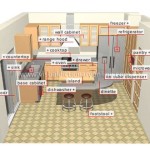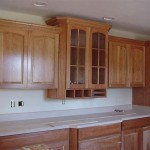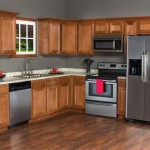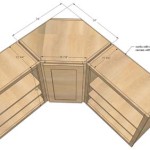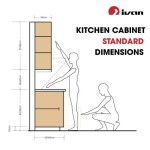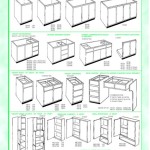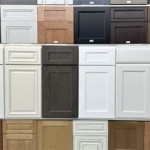Can You Spray Paint Laminate Kitchen Cabinets? A Comprehensive Guide
Laminate kitchen cabinets are a frequent feature in many homes due to their affordability and durability. However, their aesthetic appeal may diminish over time, leading homeowners to consider renovation options. Spray painting presents itself as a cost-effective alternative to replacing entire cabinet sets. While feasible, successfully spray painting laminate cabinets requires careful preparation and execution. This article provides a comprehensive overview of the process, highlighting essential steps and considerations for a durable and visually appealing finish.
Laminate surfaces, unlike solid wood, possess a smooth, non-porous composition. This inherent characteristic presents a challenge for paint adhesion. Without proper preparation, the paint is prone to chipping, peeling, and scratching. Therefore, the success of spray painting laminate cabinets hinges on meticulously addressing the surface's properties to ensure optimal paint bonding.
Proper Preparation: The Foundation for a Lasting Finish
The initial and arguably most crucial stage involves thorough preparation. This stage comprises cleaning, sanding, and priming, each playing a vital role in creating a surface conducive to paint adhesion. Skipping or compromising on any of these steps significantly increases the likelihood of paint failure.
Cleaning is paramount. Grease, dirt, and grime accumulate on kitchen cabinets over time, forming a barrier between the laminate surface and the paint. Use a strong degreaser to thoroughly clean all cabinet surfaces, both inside and out. Rinse with clean water and allow the cabinets to dry completely. This step removes contaminants that would impede paint adhesion and compromise the final finish.
Sanding introduces microscopic imperfections onto the smooth laminate surface, providing the paint with a physical key to grip onto. Use a fine-grit sandpaper (between 220 and 320 grit) and lightly sand all surfaces to be painted. The goal is not to remove the laminate layer, but to create a slightly rough texture. After sanding, remove all sanding dust with a tack cloth or a damp cloth. Ensure the surfaces are completely dry before proceeding to the next step.
Priming is the final preparatory step and is essential for creating a uniform and receptive surface for the paint. Choose a high-quality bonding primer specifically designed for slick surfaces like laminate. Apply the primer in thin, even coats, following the manufacturer's instructions. Allow the primer to dry completely before proceeding with painting. The primer acts as an intermediary layer, bonding to the laminate and providing an ideal surface for the paint to adhere to.
Selecting the Right Paint and Equipment
The choice of paint significantly impacts the durability and aesthetic appeal of the finished cabinets. Not all paints are suitable for laminate surfaces. Selecting the appropriate paint type and application equipment is crucial for achieving a professional-looking and long-lasting result.
Acrylic latex paint is generally recommended for painting laminate cabinets. It offers good adhesion, durability, and ease of cleaning. Opt for a paint with a satin or semi-gloss finish, as these finishes are more resistant to moisture and stains, which are common in kitchen environments. Alternatively, specialized cabinet paints are available, formulated specifically for use on kitchen cabinetry and offering enhanced durability and resistance to chipping and scratching.
Spray painting offers a smoother, more even finish compared to brushing or rolling. An airless sprayer or a high-volume low-pressure (HVLP) sprayer is ideal for achieving a professional-looking result. If using a spray can, choose a high-quality brand with a nozzle that provides a fine, even spray pattern. Ensure the sprayer is properly cleaned and adjusted before use. Practice on a scrap piece of material to get a feel for the sprayer and adjust the settings for optimal paint application.
In addition to the sprayer, essential equipment includes painter's tape, drop cloths, and ventilation. Painter's tape is used to mask off areas that should not be painted, such as countertops, walls, and appliances. Drop cloths protect flooring and other surfaces from paint overspray. Adequate ventilation is crucial to minimize exposure to paint fumes. Work in a well-ventilated area or wear a respirator to protect your lungs.
Mastering the Spray Painting Technique
The actual spray painting process requires a steady hand and a methodical approach. Applying thin, even coats is key to achieving a smooth, durable finish. Rushing the process or applying thick coats can lead to drips, runs, and uneven coverage.
Begin by applying a light tack coat to the cabinets. This initial coat helps the subsequent coats adhere better. Allow the tack coat to dry completely before proceeding. Follow with two or three thin, even coats of paint, allowing each coat to dry completely before applying the next. Overlapping each pass slightly ensures consistent coverage and minimizes the risk of streaks. Hold the sprayer at a consistent distance from the surface and move it in smooth, even strokes. Avoid holding the sprayer in one spot for too long, as this can lead to runs and drips.
Pay attention to edges and corners, as these areas are prone to paint build-up. Use a light touch when spraying these areas to avoid drips. If drips or runs do occur, address them immediately. Use a clean brush to smooth out the paint while it is still wet. If the paint has dried, sand down the imperfection and reapply a thin coat of paint.
After the final coat of paint has dried completely, carefully remove the painter's tape. Score the edge of the tape with a utility knife before removing it to prevent the paint from peeling. Inspect the cabinets for any imperfections and touch up as needed. Allow the paint to cure completely before reinstalling the hardware and using the cabinets. Curing time can vary depending on the type of paint used but generally takes several days to a week.
It's important to remember that environmental conditions can impact the drying and curing time of the paint. High humidity and low temperatures can slow down the process. Ensure adequate ventilation and maintain a consistent temperature for optimal results.
Throughout the entire process, patience is paramount. Rushing any step can compromise the final result. Taking the time to properly prepare the surfaces, select the right materials, and apply the paint carefully will ensure a durable and visually appealing finish that will transform the look of your kitchen cabinets.
Proper maintenance is also crucial for extending the lifespan of the painted cabinets. Clean the cabinets regularly with a mild soap and water solution. Avoid using harsh chemicals or abrasive cleaners, as these can damage the paint finish. Promptly wipe up spills to prevent stains. With proper care, spray-painted laminate cabinets can provide years of aesthetic enjoyment.

How To Paint Laminate Kitchen Cabinets Perfect Finish Tips

What Is The Best Spray Paint On Kitchen Cabinets

How To Paint Laminate Kitchen Cabinets Perfect Finish Tips

Kitchen Spray Painting The Facelift Company

Can You Spray Paint Cabinets First Home Love Life

Diy How To Revamp Melamine Kitchen Cabinets With Spray Paint My Thrifty Life By Cassie Fairy Inspiration For Living A Lovely On Budget

How To Paint Laminate Cabinets

How To Paint Kitchen Cabinets Like The Pros

Diy How To Revamp Melamine Kitchen Cabinets With Spray Paint My Thrifty Life By Cassie Fairy Inspiration For Living A Lovely On Budget

How To Paint Laminate Cabinets Everything You Need Know
Related Posts

